When team members need to come together, in-person meetings aren’t always the right answer. But neither is spending countless hours on the phone or sending email after email. And, as remote work continues to rise, you need a solution that plugs the growing gap.
That alternative to energy-sapping communication is an online meeting platform that goes beyond video chat alone.
With the right platform, you can not only schedule and start instant meetings but also benefit from productivity features like screen sharing, team chat, meeting transcripts, and more.
In this guide, we round up the top online meeting platforms. Whether you’re conducting brainstorming sessions, client meetings, training events, or large conferences, you’ll find a tailored platform that fits your needs.
What Is a Virtual Meeting Platform?
A virtual meeting platform is a software solution that enables teams to collaborate and communicate online, removing the need for in-person gatherings. It often provides real-time video, audio, and dial-in options for participants and hosts.
Powered by cloud technology, these platforms provide video conferencing combined with tools to enhance engagement, productivity, and meeting management.
Participants join meetings remotely via an app or web browser, with the session hosted entirely online.
These platforms go beyond basic video conferencing to provide robust tools that drive engagement and enhance productivity before, during, and after meetings.
Features may include screen sharing, interactive whiteboards, polling, breakout rooms, Q&A and chat, meeting recordings, and more.

Why Use a Virtual Meeting Platform
Adoption of dedicated virtual meeting solutions has skyrocketed for three key reasons:
- The pandemic forced an immediate shift from in-office to online collaboration. Without the ability to bring people together physically, companies rapidly deployed platforms like Zoom, Webex, and Microsoft Teams.
- Studies show remote teams can be just as or even more productive with the right tools. Virtual meetings empower organizations to access talent globally without being limited by geography.
- Younger, digital-native employees grew up socializing, learning, and collaborating online. They expect that same seamless experience with workplace technology.
Gartner estimates that only 25% of business meetings will occur in person driven by the demand for remote work and changing workplace demographics.
The demand for flexible remote work and the entrance of millennials and Gen Z into leadership roles is accelerating a growing trend.
Moving forward, the workforce will become increasingly dispersed, making scalable and engaging virtual meetings essential to a company’s success.
Top 12 Virtual Meeting Platforms
- Nextiva
- Google Meet
- Zoom
- Microsoft Teams
- Cisco Webex
- GoTo Meeting
- Skype
- Slack
- Lifesize
- Jitsi
- Zoho Meeting
- Tella
The Top Five Virtual Meeting Platforms Compared
| Platform | Key Features | Who Should Choose It | Monthly Pricing |
|---|---|---|---|
| Nextiva | HD video with free telephone dial-in Instant conference option Cloud-based meeting recording Integration with phone system and call center Live streaming and webinars | Great for small to medium businesses with light meeting needs. Easy install and neat interface. | Starts at $30 per user per month, including phone system and meeting platform. |
| Google Meet | Google Meet is now included as part of the wider Google Workspace program, and all apps are now better integrated. | Great for small to medium businesses with light meeting needs. Easy installation and neat interface. | Starts at $6 per user per month with a one-year commitment. Free trial for 14 days. |
| Zoom | Whiteboard during meetings and standalone Artificial intelligence (AI) meeting companion Native email and calendar solutions | Zoom has moved from meetings-only to providing calling, chat, events, and conference room solutions. | Starts at $15.99 per user per month. Free tier includes up to 40-minute meetings and limited access. |
| Microsoft Teams | Live streaming and webinars Live caption translation Integration with Microsoft apps like SharePoint, Lists, and OneNote | If your business is all-in on Microsoft apps, everything is tightly integrated. | Starts at $4 per month with an annual commitment. |
| Cisco Webex | Live streaming and webinars Live polling and Q&A during meetings Integration with in-room Cisco equipment | If you’ve been using Cisco phones or meeting equipment for years, Webex is the natural step for collaboration and virtual meetings. | Starts at $14.50 per month. Free version allows meetings up to 40 minutes and 100 attendees. |
1. Nextiva

If you’re looking for a quick setup and an easy-to-use interface, Nextiva provides just that alongside a powerful suite of features to make your meetings productive.
Outside of video conferences, you also get a cloud phone system, which allows you to make and receive calls over the internet. In some cases, your teams or certain individuals may prefer audio-only meetings.
You can turn off the video with the click of a button to cater to each specific scenario — be it low bandwidth or shy teammates.
Nextiva’s key features
Nextiva offers a suite of robust online meeting features, including:
- HD video and audio meetings powered by one of the industry’s most reliable networks
- Strives for 99.99% uptime with 24/7 monitoring for dependable meetings
- Screen-sharing and file-sharing capabilities that are secure and encrypted
- Integrated team chat accessible inside and outside of meetings
- Scheduling and joining meetings, webinars, or live streams from a unified application
- Business phone app to make calls and access meeting features from your business number
- Instant conference feature to instantly start an impromptu meeting via team chat
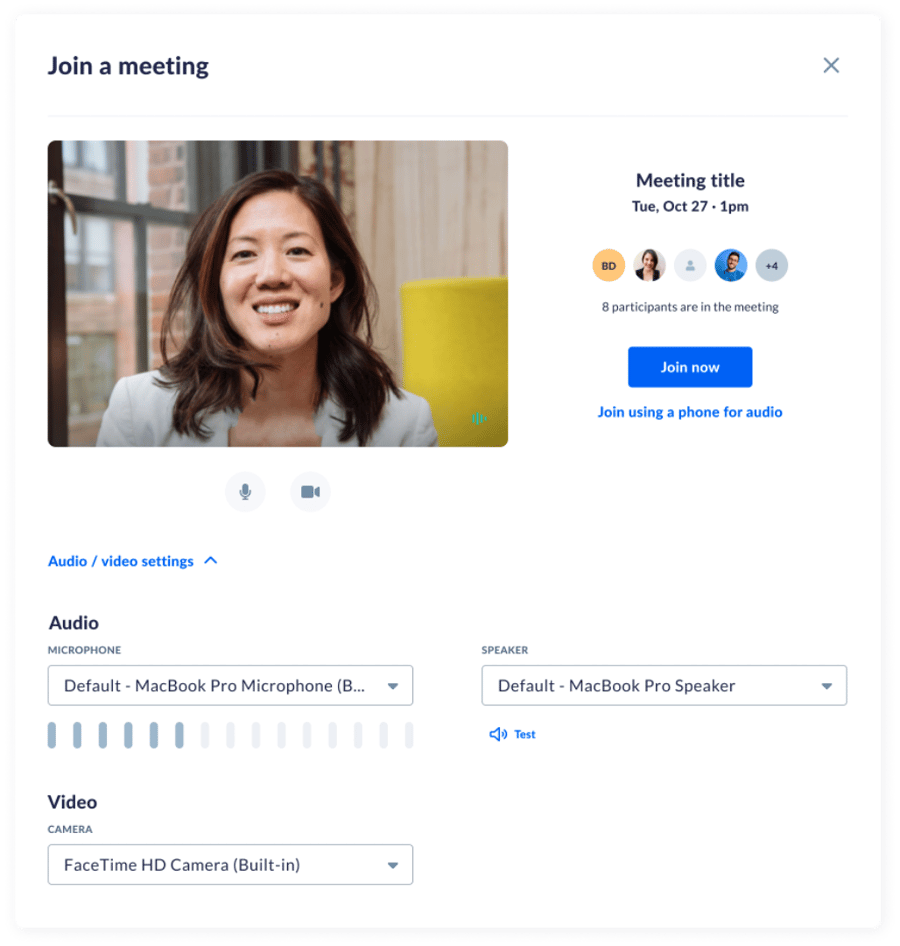
Pricing
Choose from our Core plan (starting at $30 per month) to access audio and video meetings; phone system functionality, including voicemail and toll-free numbers; and unlimited internet fax.
As you move up to the Engage plan (starting at $40 per month) and the Power Suite plan (starting at $60 per month), add features like call centers and auto attendant for intuitive call flows, with room to grow with other features like call recording, app integrations, and single sign-on.

Unique perks
Nextiva offers virtual call center software, ideal for small businesses to operate a sales or support team without paying big-business prices.

While the service is full of advanced functionality like interactive voice response (IVR), call monitoring, and call queues, the integration between your phone system and call center sets Nextiva apart.
When agents handling customers have a direct connection to your product specialists, everything flows better, and customers get a better experience.
As an extension of your business phone system, you can also send and receive SMS and MMS messages using Nextiva. End-to-end encryption is provided as standard, ensuring the security of your messages.
Best for
Nextiva is an ideal virtual meeting and communication platform for small businesses seeking an easy-to-use solution requiring minimal setup to quickly host, schedule, and join meetings.
With reliable HD video powered by a network delivering 99.99% uptime, Nextiva enables seamless collaboration for remote teams. The platform uniquely integrates a full-featured phone system allowing call centers to connect agents and back-office staff on customer calls.
Companies looking to enable flexible remote work through a secure and dependable conferencing tool can benefit from Nextiva’s out-of-the-box capabilities to have their team up and running in minutes.
Further Reading: How Integrating UCaaS & CCaaS Improves Customer Experience
2. Google Meet

When you think of Google, you probably think of searching online. But it also provides a virtual meeting platform called Google Meet. In fact, Google Meet is now part of Google’s wider productivity suite named Google Workspace (formerly G Suite).
Key features
Some of Zoom’s virtual meeting features include;
- Video meetings for up to 100 participants in entry-level Business Starter plan
- Access to full Google Workspace apps (Gmail, Drive, Docs, Sheets, Voice, Slides)
- Cloud storage included, with more storage in higher pricing tiers
- Optional add-on for Google Voice phone service
Pricing
You can get a free 14-day trial of Google Workspace if you want to test its video conferencing capabilities.
Plans start at $6 per user per month for basic access. At $12 per user per month, you get more cloud storage and open meetings with up to 150 participants. At $18 per user per month, you get open meetings with up to 500 participants, even more cloud storage, and enhanced security settings.
Enterprises must get a custom quote for enhanced support, implementation, and security management.
You can get a free 14-day trial of Google Workspace if you want to test its video conferencing capabilities.

Unique perks
As Google has owned YouTube since 2006, Google Meet allows you to stream your meetings instantly and directly to YouTube, with no need for third-party integration.
Best for
Google Meet is an ideal video conferencing solution for teams already using Gmail, Drive, Docs, and other Google Workspace apps who want seamless integration with an adopted toolset.
Its simple and intuitive interface enables fast online meetings without complexity, while encryption ensures security for customers with stringent compliance needs.
3. Zoom

While online meetings empower remote collaboration, some situations still call for in-person, face-to-face gatherings when possible. Hybrid platforms like Zoom facilitate both virtual and physical events.
As one of the first virtual meeting platforms to react to a remote work-first world, Zoom continues to add features to make it competitive with some of the best video conferencing providers in the market.
It’s the paid plans where Zoom’s innovation has been focused since the pandemic, however.
There was (and still is) a big call for virtual events. Zoom continues to host its own annual event, Zoomtopia, using its own solution alongside an in-person session.
Key features
Zoom offers plenty of features beyond just video calls, including:
- Zoom meetings with a 40-minute time limit and 100 participants for the free tier
- Integrated mail, calendar, messaging, and whiteboard tools
- Higher pricing tiers allow more attendees, longer meetings, and advanced features like AI Companion
- Top-tier plans add enterprise capabilities — cloud storage, custom domains, translated captions
Pricing
As was the attraction during the pandemic, you can still get free access to Zoom for 40-minute meetings.
When you opt for a paid plan, you save money with a yearly subscription. Prices start at $149.90 per year per user and grow to $199.90 and $250.00, respectively.
The higher the pricing tier, the more functionality you get. Do be aware that, for smaller businesses, it’s unlikely you’ll use the features at the top end of the scale.

Unique perks
Zoom was one of the first virtual meeting platforms to pioneer breakout rooms. The ability to run several sessions away from your core meeting is popular for businesses hosting virtual events. These workshop environments provide great sources of creativity and education in the right hands.
Zoom also started the trend of using virtual backgrounds and has continued to innovate with filters and blurring options. While some providers have played catch-up, Zoom continues to provide this consumer-style feel to its business platform.
Best for
Zoom is best for companies planning events that have a need for virtual attendance as well as in-person.
If you’re planning a conference and offering different types of tickets (in-person and online), Zoom is leading the way in hybrid events.
As virtual meeting platforms must do more than just provide a meeting experience, this is where Zoom has chosen to excel.
4. Microsoft Teams

Microsoft Teams is the replacement platform for Skype for Business. Previously, meetings and real-time messaging happened over Skype.
Several months after the company acquired Skype, Microsoft Teams is now the preferred virtual meeting platform for Microsoft users.
Key features
Some of Microsoft Team’s key features include:
- Video meetings with integrated team chat and online calling capabilities
- Options available to add full phone system functionality
- Excels with large meetings, offering live translated captions in 30+ languages
- Open and collaborate on Microsoft documents (Word, PowerPoint, Excel) within Teams
- Whiteboarding and annotation tools
- AI noise cancellation
Pricing
Microsoft Teams offers a free version for home users with restricted functionality.
The Teams Essentials package ($4 per user per month) provides basic meeting and chat functionality for businesses. Microsoft’s licensing then changes to include all your Microsoft apps. This becomes a different conversation from just buying a virtual meeting platform.
Speak to your Microsoft administrator, if you have one, to make sure their requirements get factored in, too.

Unique perks
With Apple CarPlay enabled you can send Teams messages with Siri for iOS using voice recognition. Additionally, if your car is smartphone-enabled, you can ask Siri to start your meeting or use the center console to read aloud and send messages.
Microsoft Teams is one of few apps that allows you to join, and even host, meetings from the driver’s seat.
Best for
Microsoft Teams is best for large businesses who are already using Windows and the Microsoft suite of tools for productivity.
If you already use apps like SharePoint, OneNote, Lists, etc., integration into Teams is a win-win for users and administrators.
5. Cisco Webex
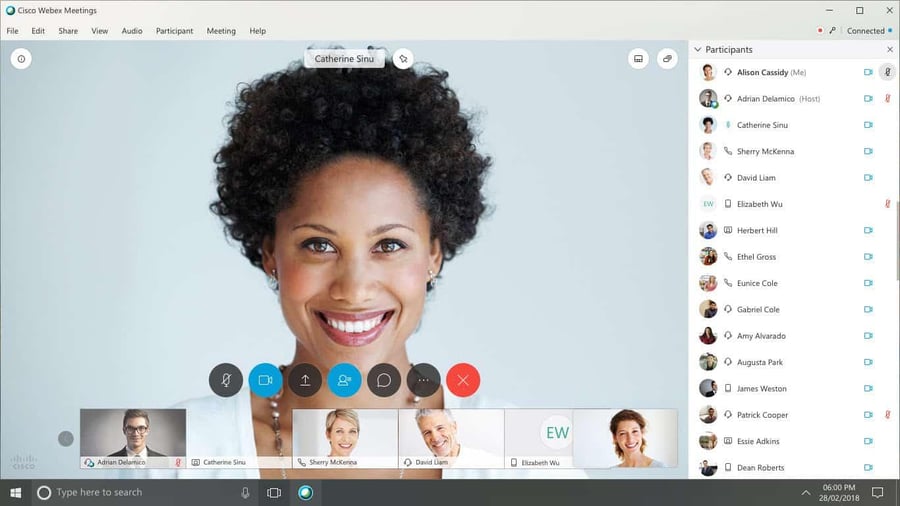
Cisco bought Webex in 2007 and has, over time, turned Webex into its main virtual meeting platform.
As one of the oldest video conferencing tools on this list, it might be surprising that Cisco only went all in on video conferencing software in recent times.
The scale of Cisco’s legacy client base has made migration and innovation between products relatively difficult.
Key features
Some of Cisco Webex’s key features include:
- Video meetings with integrated messaging and online calling
- Add-on options for external phone system capabilities
- Host meetings with up to 1,000 participants (depending on license)
- Features like call recording, team chat, screen sharing
- Higher tiers add capabilities include closed captions, co-hosting, and live polling
Pricing
You can sign up for 40-minute meetings with up to 100 attendees for free.
For anything above this, you must move to the $14.50 Starter plan, $25 Business plan, or custom Enterprise plan. As you move up the pricing tiers, you unlock more meeting participants and higher security features.
Related: Cisco Webex Contact Center Pricing: Is It Worth It?
Unique perks
A new addition to the Webex feature set is the acknowledgment that you’ve left your desk.
If you have an emergency child situation or need to rush to the door when working from home, Webex auto detects you’ve left and will blur your screen. There’s no need to wait for an okay time to excuse yourself, and everyone knows you’re temporarily away.
Best for
Hosting large-scale video conferences is Cisco’s thing.
Its legacy of kitting out conference rooms, stages, and events remains true with its virtual meeting platform.
Most of Webex’s customers are enterprises with large meetings, now with virtual and remote attendees. As such, they’re already using Cisco’s room equipment and benefitting from Cisco’s professional services.
6. GoTo Meeting
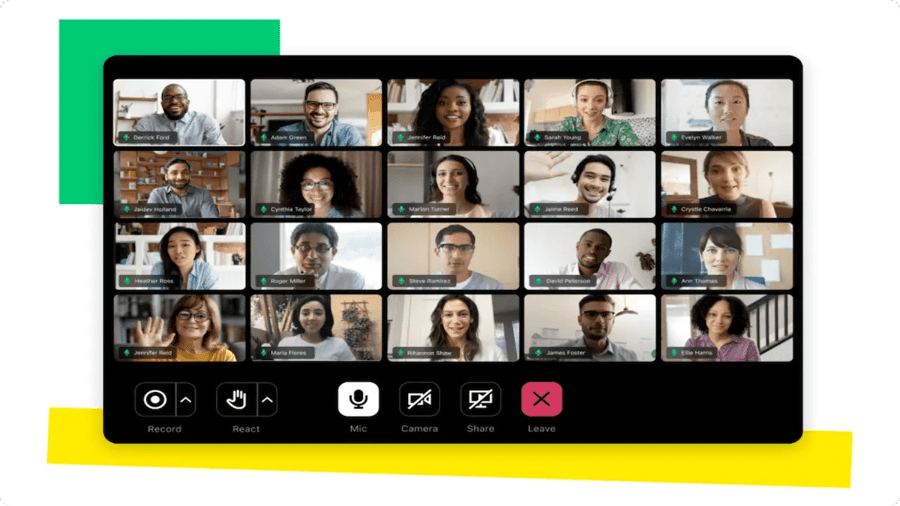
GoTo Meeting started out life as a spin-off of a remote access tool, saw success as a webinar tool (GoTo Webinar), and has most recently gone through a merger with LogMeIn.
Combining the feature sets of both GoTo and LogMeIn, the latest version of this virtual meeting platform contains video meetings, audio meetings, and in-session messaging. It’s also a decent Dialpad alternative with its collaboration functionality.
Key features
GoTo Meeting’s key features include:
- Browser-based meetings with breakout rooms, noise suppression, dial-in audio
- Recording, transcription, annotation, screen sharing, virtual backgrounds
- Security: single sign-on, ability to dismiss attendees, end-to-end encryption (coming soon)
Pricing
GoTo Meeting has two main pricing tiers but is billed per meeting organizer rather than per user.
As the standalone meeting product doesn’t include team collaboration services like business messaging or phone systems, pricing tiers are $12 per organizer per month and $16 per organizer per month. The main difference is the attendee cap: 150 and 250, respectively.
There is a custom Enterprise option that includes bulk buying webinars, phone, and meeting solutions.
Unique perks
GoTo Meeting now lets you convert a slide you’re presenting into a PDF to share with meeting attendees. If someone asks for a copy of the slide deck, you can send them a read-only version in just a few clicks without leaving the meeting.
Best for
Medium-sized businesses looking for a standalone virtual meeting platform.
If the wider suite of collaboration services, like calling and messaging, isn’t part of your need, GoTo Meeting provides a simple option.
7. Skype

Have you used Skype for family or personal calls?
It’s a major convenience for people with family and friends abroad who don’t want to incur an expensive bill making international calls. Widely used as a free VoIP app, Skype makes communication accessible for everyone.
While consumer apps like FaceTime and WhatsApp have proven more popular for one-to-one calling in recent times, Skype could be considered an option for small businesses with basic meeting needs.
Key features
Skype offers the following key features:
- Schedule and join online meetings
- Screen sharing, virtual backgrounds
- Features like call recording, hand raise, reactions
- Presence indicators, instant messaging
- Option to reserve phone number for calling, SMS/MMS messaging, and meetings
Pricing
Making Skype-to-Skype calls is free. This presents itself as an attractive virtual meeting platform for any business. But, while this feature set has progressed from a one-to-one video call with your nan, Microsoft’s focus on business meetings lies firmly in Microsoft Teams.
Skype’s mobile and landline functionality works on a pay-as-you-go credit basis. You can buy credits of $5, $10, or $25 to top-up your account for mobile and landline calls.
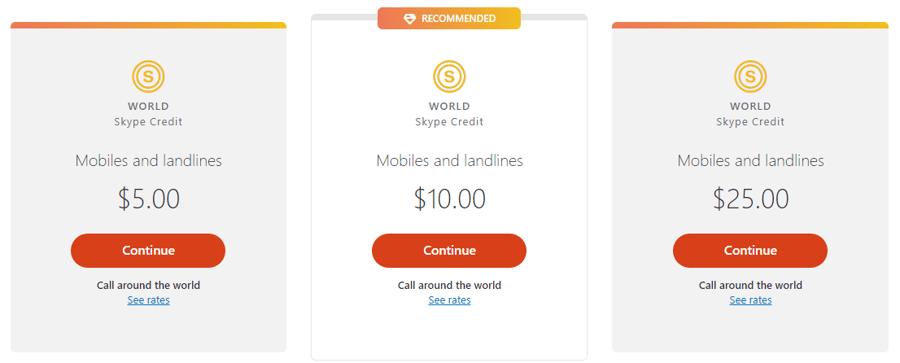
Unique perks
You can use the same Skype account for your personal and business lives.
If you want all your contacts in a single platform, Skype can be the place where you meet everyone.
Best for
Solopreneurs or teams of two or three looking for a cheap option to make video calls with external contacts, like suppliers and freelancers.
8. Slack

Slack’s focus is asynchronous communication. Its original and core functionality is messaging, but not the instant kind.
Slack is arguably the pioneer of asynchronous messaging, especially in business. Having long-lasting contextual messages that don’t disappear means you can send a message on Monday and return to the conversation on Thursday.
Some users, however, suggest Slack is too overwhelming for them.
With constant notifications, as businesses start to rely on messaging, these types of users are more likely to prefer a virtual meeting platform where video conferencing is the core function. That said, there is still the ability to start video and audio meetings inside Slack.
Key features
Here are some of Slack’s key features.
- Huddles: impromptu video or audio sessions in channels/chats
- Huddle features: screen sharing, live captions, invite links
- No built-in meeting scheduling
- Integrations available with third-party video platforms to start meetings in Slack
Pricing
As Slack doesn’t have its own virtual meeting software, choosing a pricing option is down to the messaging aspect of your collaboration experience.
If your goal is to enable asynchronous messaging across your business, the Free plan includes a 90-day message history and one-to-one and group calls.
This may be ideal for businesses that need impromptu meeting functionality but don’t need to schedule meetings.
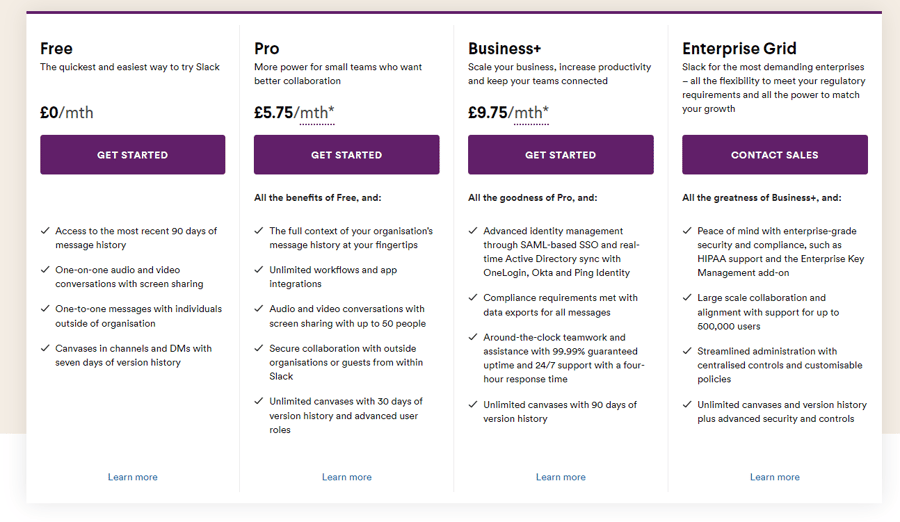
Unique perks
Slack’s message threading experience is among the best in the collaboration market. The ability to pick up conversations where you left them, switch between messages without losing the context, and set up custom notification schedules is a productive way of working for those messaging first.
Best for
Companies looking for an asynchronous messaging option with minimal need for virtual meetings.
If the chance of you scheduling a meeting is low, Slack provides a good alternative to the standard video conferencing platform.
9. Lifesize
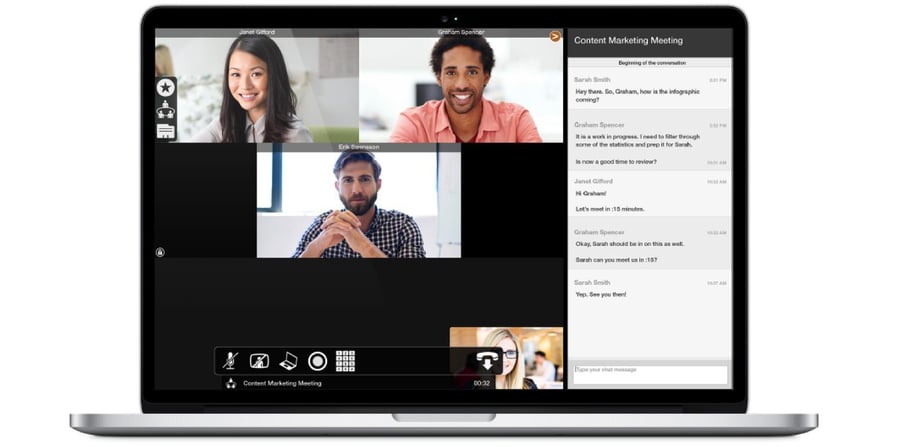
Lifesize, recently acquired by Enghouse Systems, provides video conferencing and meeting room solutions. These are often coupled and include hardware components like webcams and conference phones.
Key features
- Standard video/audio conferencing
- Screen/file sharing, live streaming, meeting recording
- Standout capability to integrate hardware and software for “in the room” experience for remote participants through smart 4K video technology
Pricing
Lifesize’s meeting solutions are split into Plus and Enterprise packages, starting from $14.95.
Recognizing its target market will have nuances like in-room configuration, you must request a quote with your exact requirements to get plan pricing.

Unique perks
Lifesize specializes in meeting room interoperability. This means you’re able to run Lifesize meeting room hardware using other platforms like Microsoft Teams or Zoom.
This can differ from site to site or office to office.
Best for
Businesses ready to invest in new meeting room equipment already have a virtual meeting platform.
If your main need is hardware, Lifesize provides a new in-room experience integrated with your existing software.
10. Jitsi
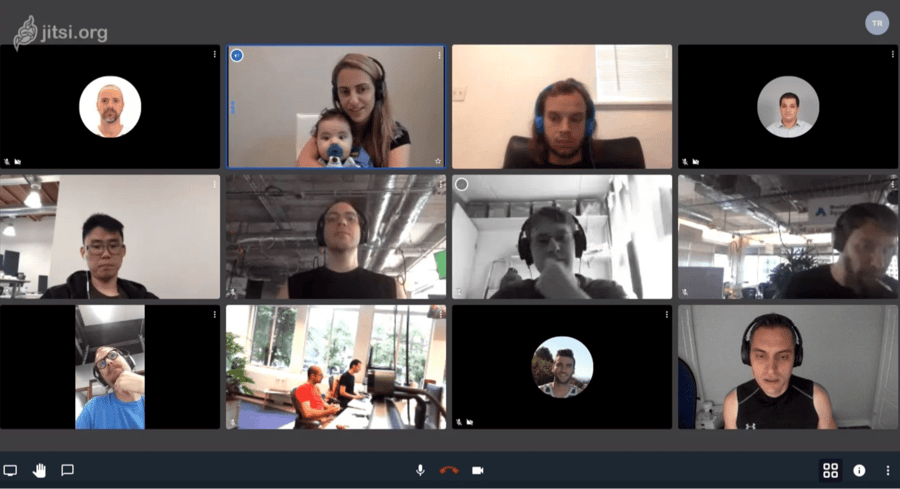
Owned by 8×8, Jitsi is the standalone virtual meeting offering from the VoIP and contact center provider.
The core functionality behind Jitsi is its webhooks and APIs that allow you to create your own brand experience and almost build your conferencing solution. As such, it’s a specialist virtual meeting platform created with developers in mind.
Key features
- Open source platform that developers can build custom video conferencing solutions on top of
- Access to low-level APIs to customize the platform
Pricing
Jitsi has several pricing tiers that increase as you add users.
The free plan, aimed at developers, is suitable for meetings with up to 25 people. As you start to use Jitsi for more than development use, the cost increases as more participants command more functionality.

Unique perks
The combination of Jitsi’s customizability and HIPAA-compatible video meetings means healthcare providers can build their virtual consultation software instead of investing in expensive, done-for-you solutions.
Best for
Businesses with engineering resources looking to create a custom video conferencing platform.
11. Zoho Meeting

Zoho Meeting is one of over 100 Zoho apps in its marketplace. Its simple interface follows the theme of the rest of the Zoho portfolio and can be integrated into other Zoho apps or with third-party solutions.
Key features
- Core video conferencing (HD video, screen sharing)
- Webinar hosting and live streaming
- Additional capabilities include virtual backgrounds, recurring meeting scheduling, and online whiteboard
- Integrates with Zoho CRM for appointment booking (requires some additional configuration and trial-and-error, but once set, it works fine)
Pricing
Zoho prices its virtual meeting platform per host per month and by the number of meeting participants.
If you need webinar access, the price jumps to $19 per month when billed annually.
A free version with limited features is also capped at 100 attendees.

Here is an indication of the pricing increases as you add more attendees.
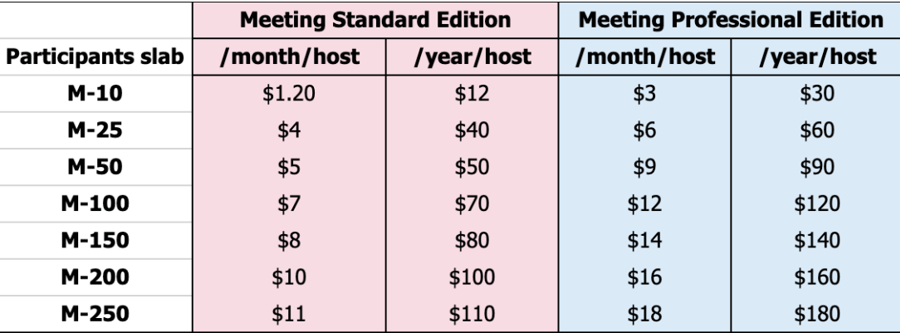
Unique perks
Zoho Meeting is one of many apps in the Zoho portfolio. As such, it’s better suited for integrating into any of those more than other virtual meeting platforms.
For example, you might subscribe to Zoho Marketing or Zoho CRM. Embedding your video conferencing solution inside these is a major win for productivity.
Best for
Existing users of apps within the Zoho suite will find Zoho Meeting easy to use as it’s uniform with other apps in the portfolio.
12. Tella

One Atlassian study reported we spend more than 31 hours every month wasting time in meetings.
As a non-live solution, Tella is an app that enables asynchronous video, meaning you send updates via video instead of getting everyone together. The result?
Everyone gets the information they need. Nobody’s deep work gets interrupted.
Features
Tella is full of video recording features as an alternative to having meetings. These include:
- 4K video recording
- Screen sharing
- A comprehensive editing suite
- Virtual backgrounds
- Automatic subtitles
- Shareable links
- Adjustable screen positions
Pricing
It’s free to start using Tella. You can get a free seven-day trial without entering your credit card details. After that, choose from $15 per month for an individual user or $12 per month per user for a team license (a minimum of three users is needed).
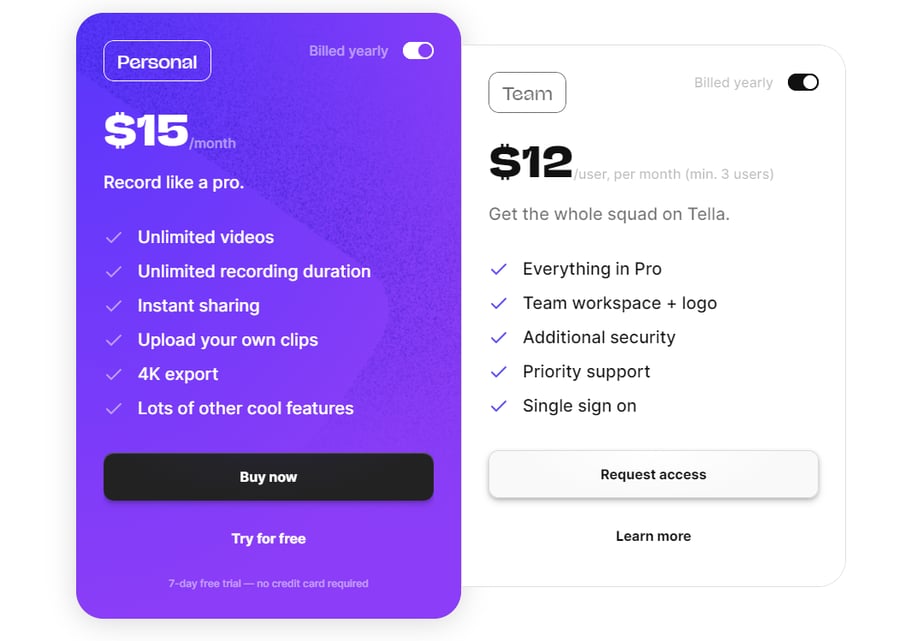
Unique perks
It’s a bit like having a meeting by yourself and then distributing it to the people you would have invited to the meeting.
You can create videos for product updates, answer inbound inquiries, or relay important company updates without requiring everyone to put down their tools and join a meeting.
Best for
Remote teams used to asynchronous work, and those who trust their teams to watch and respond to important meeting updates.
Features To Look for in Online Meeting Software
At minimum, top virtual meeting platforms provide high-quality video conferencing enabling multiple participants to join audio and video calls. Most also include:
- Screen sharing to present documents, slides, and more to attendees
- File sharing capabilities
- Audio-only conferencing for quick calls without video
- Mobile apps allowing meetings on the go
- Recording and storage of meetings in the cloud
- Integrated phone systems replacing traditional landlines
When choosing a platform for team meetings and collaboration, make sure to evaluate both video conferencing capabilities and messaging or chat features that facilitate constant communication between team members.
Within these robust platforms aimed at streamlining teamwork, you’ll also find more advanced capabilities. This includes features like AI-powered meeting summaries, noise cancellation, live translation, virtual whiteboards, and integration with popular business apps.
Leading solutions provide mobile apps on both Android and iOS operating systems, ensuring flexibility to join meetings from whichever device you have on hand, whether desktop or mobile.
As you evaluate options, identify which unique elements are must-have or nice-to-have to empower productivity, engagement, and tailored workflows.
How To Choose a Virtual Meeting Platform
Here are some tips on how to choose the best virtual meeting platform for your needs:
- Identify your key priorities — Do you need robust meeting features, webinars, team messaging, an integrated phone system, or other capabilities? Rank the must-haves.
- Consider your team size — Some platforms work better for smaller groups, while enterprise-grade solutions handle thousands. The scale should match needs.
- Evaluate ease of use — Platforms with simple interfaces don’t require heavy training or onboarding for organizers and participants.
- Assess interoperability — Support for all device types (desktop, mobile, browser-based) ensures flexibility.
- Review pricing tiers — Balance features with the number of users and budget. Watch for hidden fees.
- Check reviews and ask peers — Get feedback from real users and ask colleagues what has worked well for them.
- Sign up for free trials — Before committing, take advantage of free trials or demo offerings to test meeting workflows relevant to your team like screen sharing, recording, live streaming, etc.
- Confirm security & compliance — Encryption, data privacy and compliance certifications (HIPAA, SOC2, etc) are critical for many organizations.
The Virtual Meeting Market Is Vast — And Nextiva Helps
It’s been a big year for video, to say the least.
The virtual meeting market is full of options, each with a unique approach to hosting live meetings. Choosing the right one is all about matching available functionality with your core needs.
For example, if your business uses Microsoft for everything, there’s a strong case for using Teams for meetings.
Likewise, choosing Nextiva for its all-inclusive phone system, video conferencing, and call center integration makes sense if you don’t want to deal with separate apps or a complicated IT rollout.
For entrepreneurs, a standalone platform for meetings can work great.
With its bundled phone system, conferencing tool, and call center software, Nextiva positions itself as an all-in-one unified communications platform requiring minimal integration or setup across these key capabilities.
Ready for a better virtual meeting platform?
See how Nextiva boosts your team’s productivity.

















 Business Communication
Business Communication 









